It may be hard to believe, but over two centuries ago, a man by the name of Michael Faraday invented the electric motor, the first dynamo, and what would come to be known as the Faraday cage. By coating a room entirely with metal foil, Faraday could prevent electromagnetic fields outside the room from interfering with sensitive equipment inside. Conversely, signals from inside the Faraday cage could not escape. At first it was useful for scientific research, but has since expanded into other realms, most notably in recent times for data security. Today, the concept behind a Faraday cage is still used in everything from science labs to USB cables, and even prison buildings. Some folks have probably experienced the effects of a Faraday cage by trying to make a call on their cell phone in an elevator, or in a steel structured building. Wireless signals from devices are unable to get in or out, a feature mimicked with the SLNT E3 Faraday Backpack.
In the digital age, Faraday’s methods of blocking signals have become increasingly important for safety and security. Nefarious individuals can use active and passive devices to read RFID or NFC chips embedded into cards, steal information from smart devices, and possibly even damage hardware. A study at the University of Maryland found that there is a “near-constant rate of hacker attacks on computers with internet access,” equating to an average of 2,244 attempts per day per device studied — most of these attacks are automated brute-force techniques probing every computer they can find, leaving users blissfully unaware they’re happening. Even Mother Nature can take its toll on electronics in the form of solar radiation or geomagnetic storms. Look up the Carrington Event for an idea of how destructive our own sun has the potential to be. Society has become intrinsically intertwined with electronic devices, and we increasingly rely on them to store critical information. Now more than ever, it is important to find a way to keep those devices safe from tampering or destruction. But who wants to carry around a metal shielded box or line an entire room in foil?
This is where the company SLNT comes to the rescue. By incorporating metallic fabric into common everyday carry items, like wallets, purses, and backpacks, they’ve leveled the electronic warfare playing field. One of their items, the E3 Faraday Backpack, is particularly versatile. Electronic shielding lines parts of this pack, some of which is Military Standard 188-125-2 compliant, which means it’s rated to block the effects of a high-altitude electromagnetic pulse (HEMP). For anyone who hasn’t read the book One Second After, it is a well-known fact that a single HEMP has the capability to cripple most of the continental United States for years. It also exceeds IEEE 299-2006 standards, which covers radio frequency ranges between 1 and 40 GHz. These are ratings meant to ensure nuclear missile silos and sensitive database infrastructure will be able to survive mutually assured destruction, so a bag built to withstand that level of electromagnetic power should be able to block malicious short-range hackers.
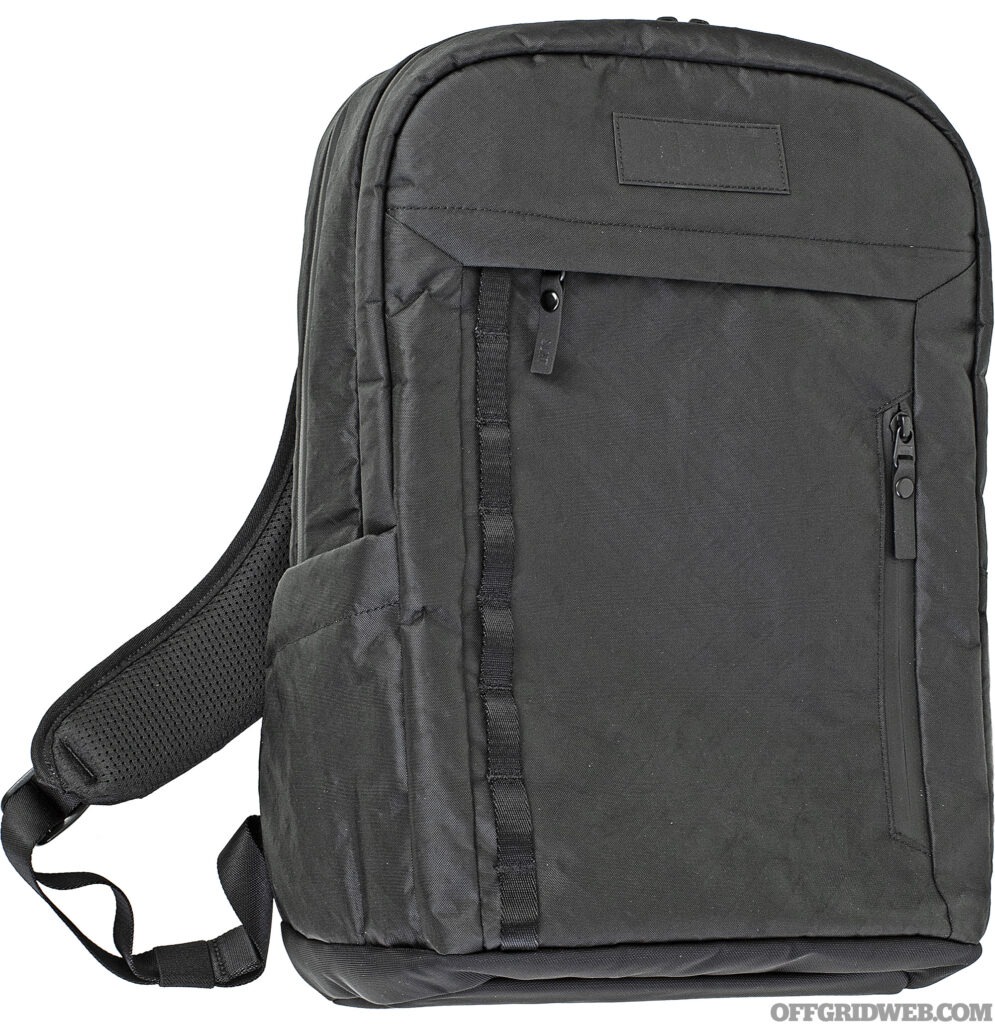
Above: Disguised as a classy EDC day pack, SLNT’s E3 Faraday backpack blocks nefarious wireless signals.
SLNT E3 Faraday Backpack
The E3 is a 23-liter bag, measuring 20.5 by 12.2 by 7.1 inches (52 by 31 by 18 cm), which makes it quite handy for day pack or airplane carry-on. It’s black and stylish, giving it a professional vibe for the office or school, and looks like a pack you wouldn’t be embarrassed to bring to a meeting. For those environmentally minded, the material is made from 100-percent recycled products and is coated to increase weather resistance. A total of 15 separate compartments allow for plenty of storage options, and it comes with a removable shoe or laundry bag to keep items such as gym clothes separate from the rest of your gear. One of the shoulder straps is designed with an easily accessible zippered pocket, perfect for a key fob, room key or thumb drive. Connecting the two shoulder straps is a magnetic sternum strap that helps reduce shoulder strain. Inside, two sizes of silent-pocket Faraday sleeves magnetically lock into place — one large enough to store a 16-inch laptop and a smaller one for a large model of smartphone. The entire bag comes packaged in a lightweight dust cover perfect for use as a dirty laundry bag when you’re on the go.
This bag looks good and sounds good on paper, but we’re interested in real-world performance. So, let’s take a deeper dive into its effectiveness at blocking signals and see if it lives up to the company’s claims. SLNT’s website has an entire page dedicated to its own testing results that looks impressive. Call me a bit of a skeptic, but it’s easy to make claims and fabricate tables to back them up, so I like to verify things independently. To perform my own testing, I downloaded a few apps to an iPhone 12 that’ll test upload and download speeds, GPS communications, Bluetooth connectivity, and run it through some common scenarios.
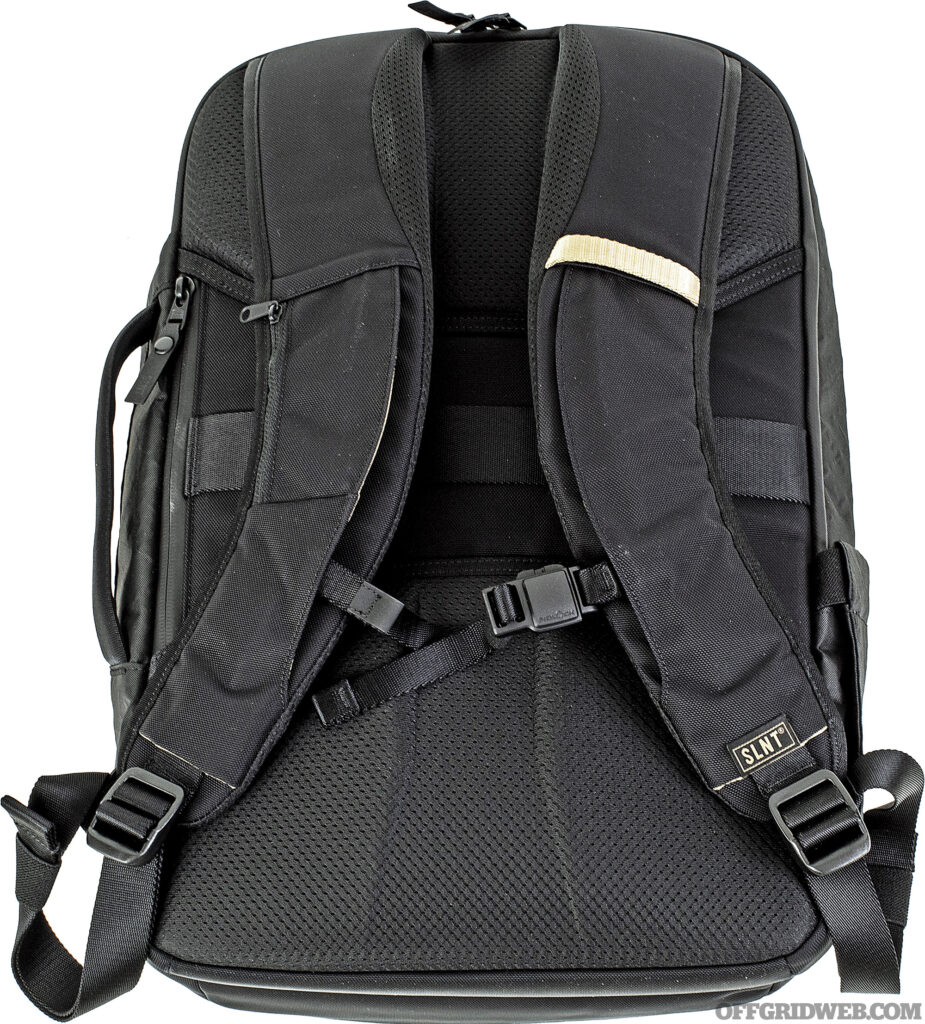
Above: There is ample padding on the backs and shoulders for increased breathability and comfort.
Testing Faraday Capabilities
To establish a baseline of the phone working normally, the signal testing apps were run with the phone in the open air. Signal testing is performed inside a residence built with an aluminum roof, and about 4 meters from a Wi-Fi router. Inside the house are several devices that connect via Bluetooth, and there’s a 4G cellular tower less than a half-mile away. This location is in a sparsely populated residential zone in the Upper Peninsula of Michigan, and the signal density isn’t as high as you would find in a metropolitan area. The phone settings are typical of what would be used to conserve data, connecting to known Wi-Fi networks when they’re available, and using cellular data when they’re not.
Unfortunately, if a phone’s settings allow it to automatically connect to signals as it comes within range, it becomes vulnerable to attacks from hackers lurking on unsecured networks. Even secured networks can be hacked with enough time and effort, allowing whoever is on the other side to victimize any devices that are connected. So, it pays to take device protection seriously. Smartphone at the ready, I began to test how well the E3 can prevent these types of attacks from occurring in the first place.
The aforementioned apps indicated that baseline data transfer speeds on the smartphone were relatively fast, with average download speeds between 80 and 100 Mbps, and upload speeds clocking in between 10 and 13 Mbps. GPS status varied more drastically inside the residence with error rates ranging between 10 and 50 feet horizontally. Perhaps this was due to the aluminum roof, or the location of GPS satellites. Regardless of the reason, the phone was tracking my location. Bluetooth connectivity functioned normally, with the phone able to easily detect the devices communicating with it, such as headphones and smart devices. As expected, the phone was functioning the way it usually does, and was able to communicate with the world around it.
Still inside the building, I placed the phone in the main backpack compartment, closed the zipper, and started running the speed tests. For reference, modern Wi-Fi routers run between 2 and 5 gigahertz (GHz), GPS communicates near the 1.5 GHz range, and Bluetooth communicates near the 2.4 GHz range. Cell phones can make use of a huge range of frequencies, between 600 MHz and 39 GHz, depending on the carrier. RFID chips can use anything between around 500 MHz and 1 GHz, and in the U.S., key fobs operate in the around the 315 MHz range.
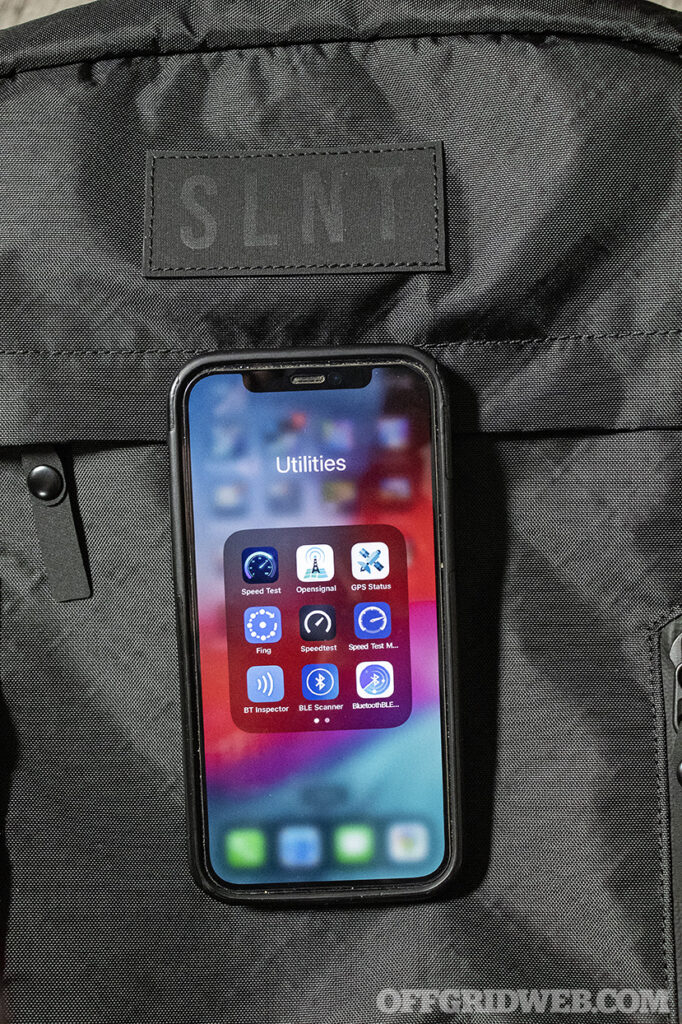
Above: Using numerous connection testing apps, E3’s signal-blocking capabilities were put to the test, specifically cellular, Wi-Fi, Bluetooth and GPS signals.
After running the test inside the main backpack compartment, the app reported that data transfer speed was slightly diminished, but the phone was still connecting to both Wi-Fi and cellular data with relatively fast speed. The smartphone did not detect Bluetooth objects that were greater than 5 meters away, and GPS error margins increased dramatically. Similar results were obtained in the second large backpack compartment as well. It seems that these main compartments have more of an effect on electromagnetic frequencies between 1.5 and 2.4 GHz, and only a slight impact on the 2 to 5 GHz range.
Nestled close to the back of the pack is a pocket made for passports and other travel documents. The lining of this pocket makes a louder metallic crackling noise when it’s opened, suggesting there’s a thicker Faraday lining. The same connectivity tests were repeated with the zipper closed, and the results were similar to what occurred in the main compartments of the pack: slightly slower transfer speeds, much larger GPS error margins, and reduced Bluetooth detection. To test something with a different frequency range, a key fob was placed in this travel document pocket, zipped closed, and the buttons were pressed through the outside of the pack. However, the key fob was able to communicate with the vehicle, even while enclosed in the pack. What this back pocket did well was to prevent my smartphone from reading an NFC tag, which suggests that most of the backpack prevents low frequency electromagnetic radiation from getting to whatever is inside.
Moving on to the more serious protective features are two specially shielded removable pouches, magnetically clipped inside the E3, which SLNT dubs the Silent Pocket. One is smartphone sized, and another is laptop sized. These two pouches specifically are the ones with the Mil-spec and IEEE ratings. Once an electronic device is placed inside, it’s supposed to be safe from cellular, GPS, Wi-Fi, Bluetooth, RFID, NFC, EMR, EMF, EMPs, and solar radiation. Each pouch opens and closes silently with a magnetic strip holding it closed. No obnoxious-sounding Velcro to wake up a passenger sleeping next to you on a trip or draw unwanted attention in a public setting. This seal is tight enough to feel confident, knowing that an expensive electronic will not fall out when it is jostled around.
After placing a smartphone inside the Faraday pouch, the same connectivity tests were run, and the results were much more dramatic. Simply put, there was no connectivity once placed inside the pouch — no cell tower communication, no Wi-Fi connection, and no Bluetooth pairing. I recruited someone with my contact info to call and send messages while my phone remained in the sealed Faraday pouch. They were unable to send anything through, and from their end, it looked like my phone was turned off completely. Placing a laptop in the appropriately sized Faraday pouch yielded the same results. No signals got in, and nothing got out. Sadly, I do not have the power to detonate a HEMP or control the flow of solar radiation, but I think it’s safe to assume that these Silent Pockets will offer a decent, if not total, amount of protection.
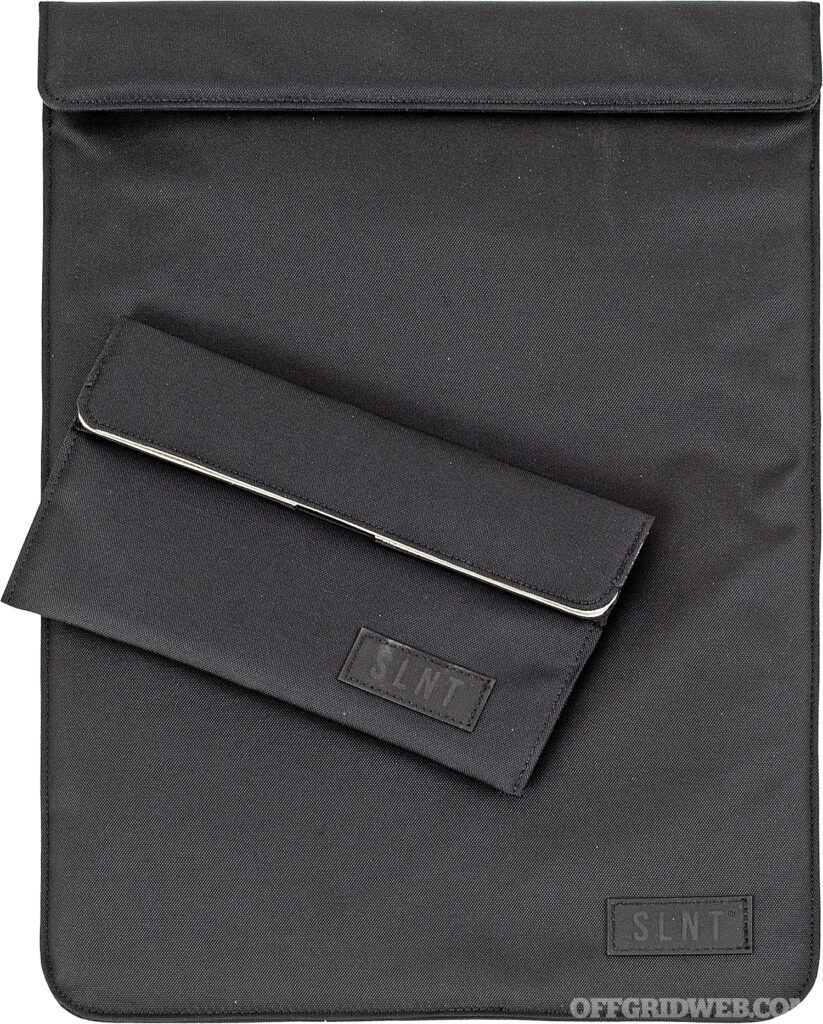
Above: Two detachable faraday pouches are magnetically clipped into specific places within the E3 Faraday Backpack.
Faraday Effectiveness
SLNT’s E3 Faraday Backpack looks great and is one of the most functional packs for EDC purposes I’ve had the opportunity to review. Overall, the pack has minimal shielding, suitable only for protecting RFID cards and tags from being scanned, but it’s material is sturdy enough to protect from most inclement weather elements. Its shoulder straps are comfortable, and the padding against the wearer’s back will maintain comfort and airflow while out and about. For more serious electromagnetic defense, electronics need to be placed and sealed completely inside one of the removable Faraday Silent Pockets. Once inside, nothing can communicate with or damage the device via electromagnetic fields.
Data is huge in our modern era, especially user-specific data regarding individuals. Thanks to the GPS functionality of the devices we carry every day, corporations and governments can actively or passively track our every move and establish patterns. With enough of this kind of information, a profile can be built, and some entity or agency can start to understand us better than we understand ourselves. While this is going on, unethical, tech-savvy hackers can use wireless vulnerabilities to read sensitive data from our mobile devices. This knowledge can make data security feel like an insurmountable threat that’s too complicated to think about or prepare for.
Thankfully, few preparations are easier than putting a device in a bag. That simple action with SLNT’s E3 Faraday Backpack and Silent Pockets could be what prevents a stolen identity, data theft or destruction, and possibly years of heartache. Many people, when they think about a disaster, often experience cognitive dissonance in the form of, “it could never happen to me.” But why even take the chance when options like this exist?
About
Make & Model
SLNT: E3 Faraday Backpack
MSRP
$330
URL
slnt.com
Related Posts
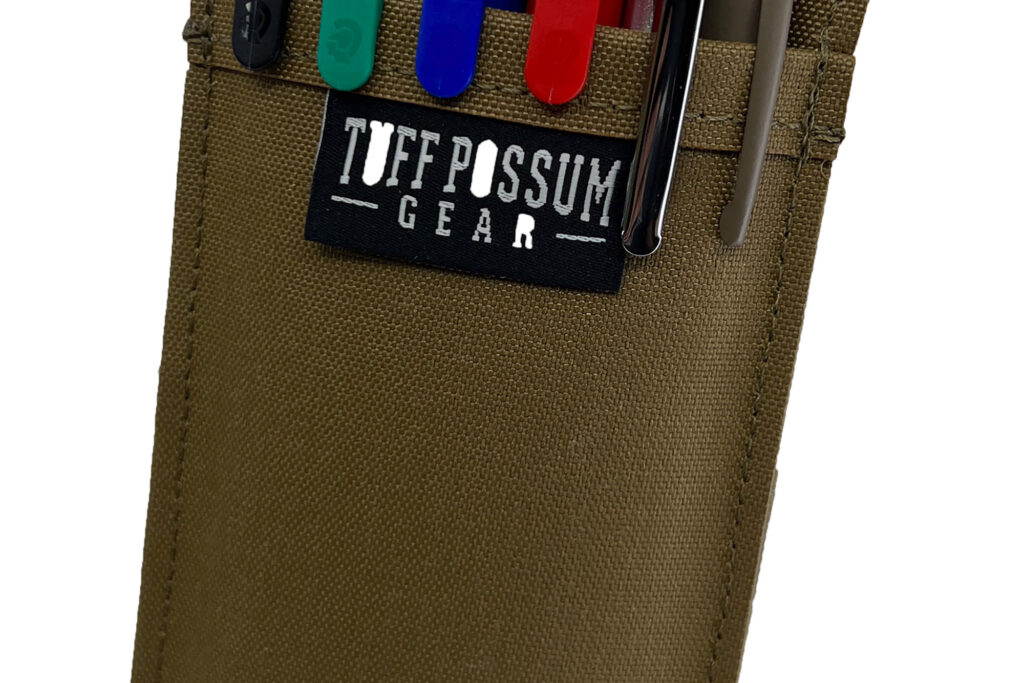
Field Writing Caddy: Organization for the Tactical AdminPocket protectors aren't just for doctors and physicists anymore now that the Field Writing Caddy is here to keep things organized.
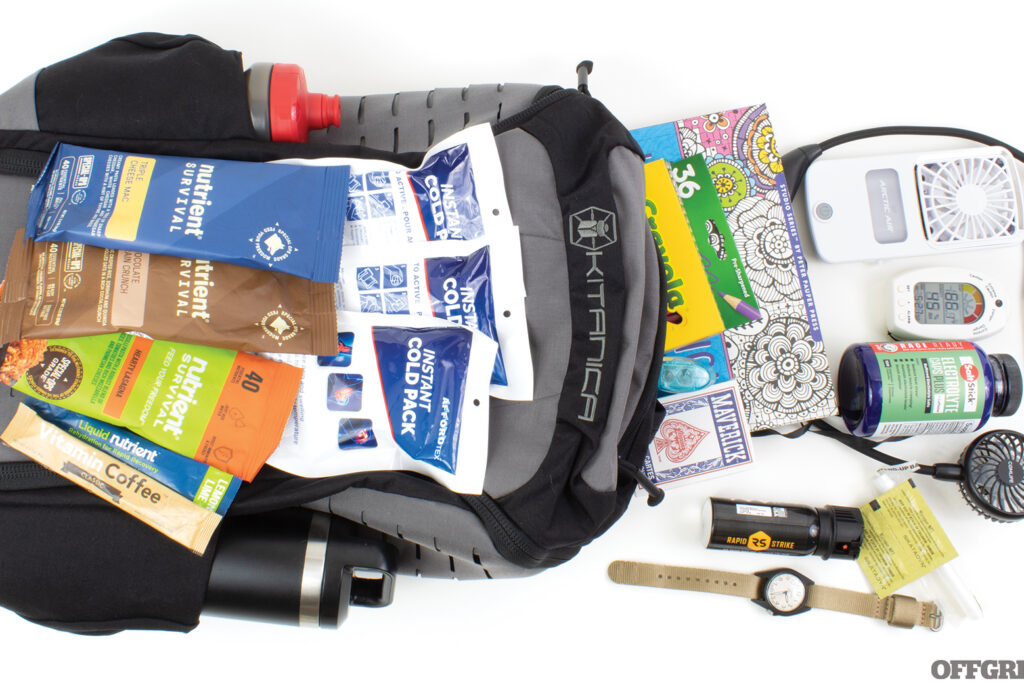
Bag Drop: A Heated SituationA look at a discreet backpack configured for surviving unexpected blackouts during extreme hot-weather conditions.
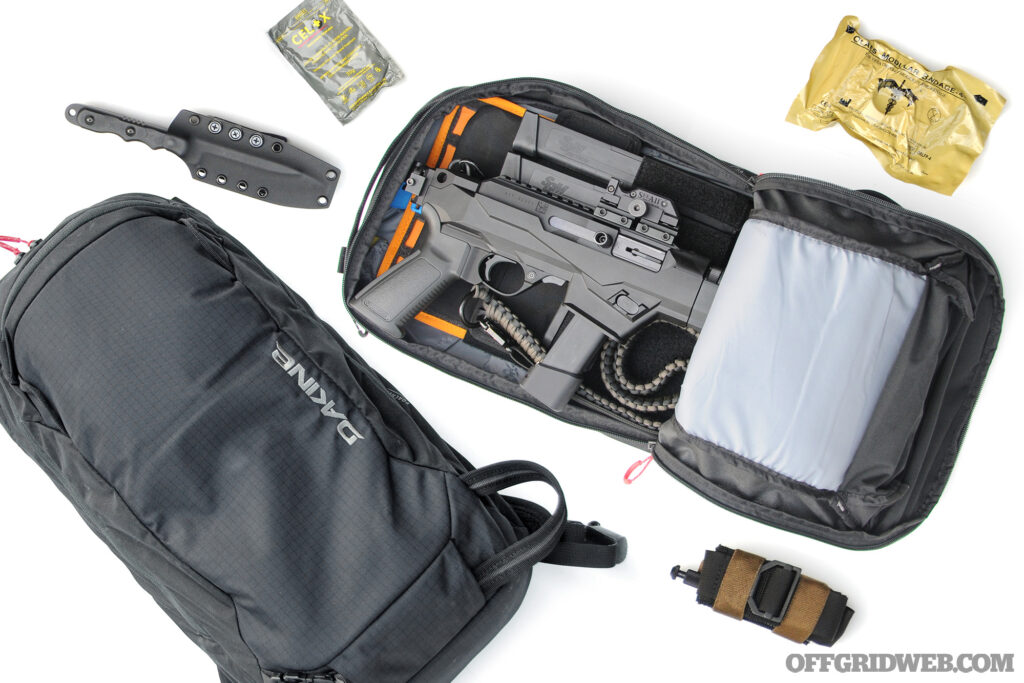
Bag Drop: Ruger PC Charger BackpackThe compact and adaptable Ruger PC Charger 9mm is quickly becoming an industry front runner for pistol-caliber backpack guns.
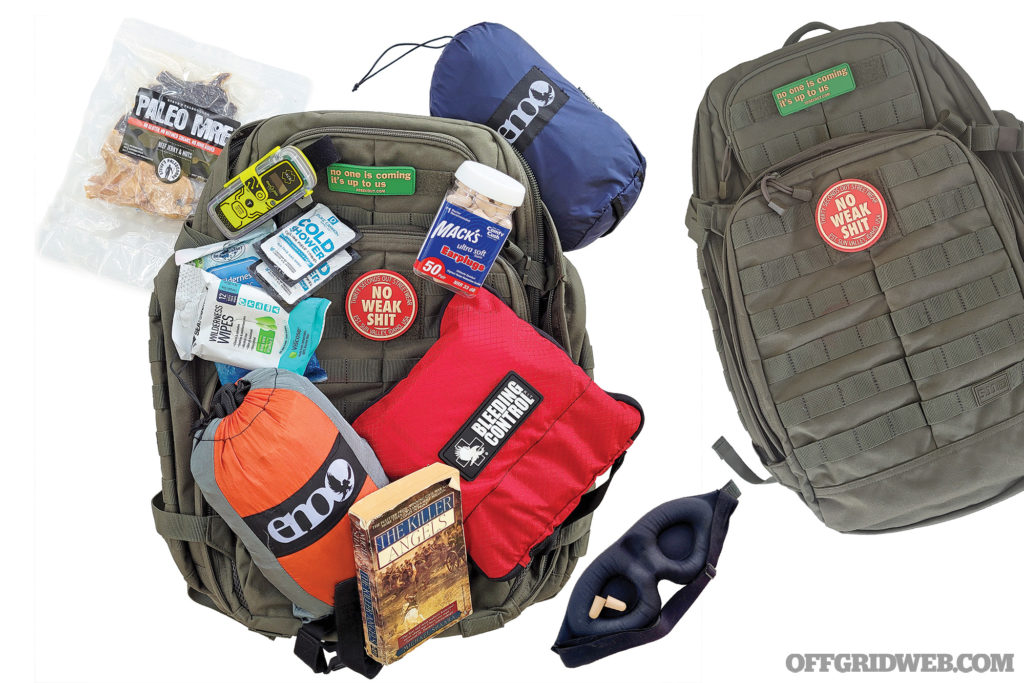
Bag Drop: 5.11 Tactical RUSH72 Search and Rescue PackI keep this RUSH72 backpack inside a vehicle, except for the rare occasion I’m out in the field and away from basecamp overnight.
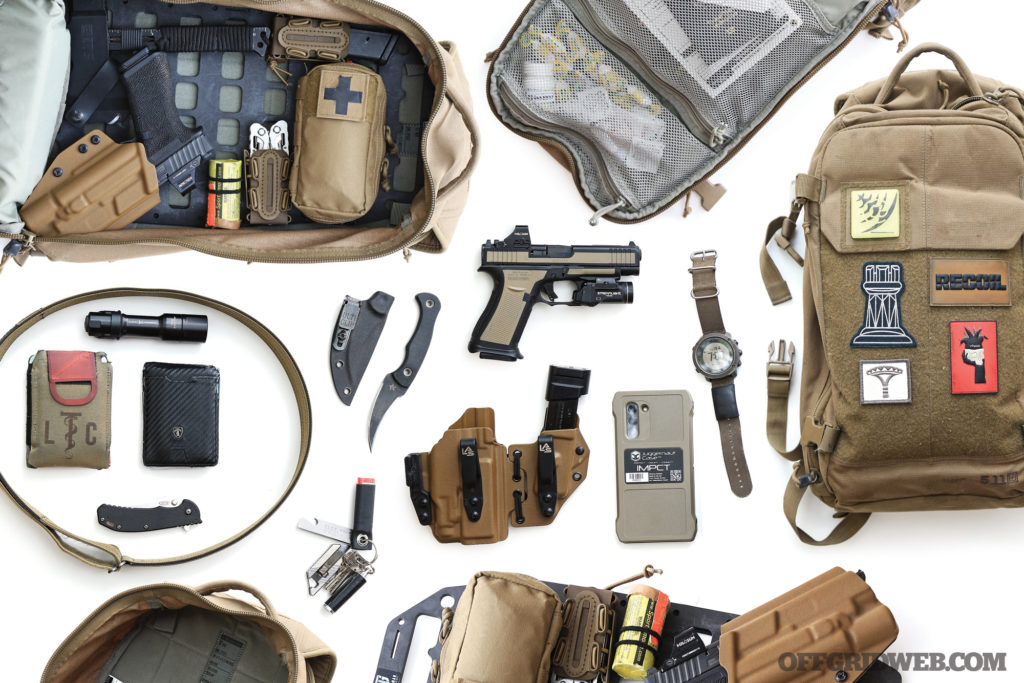
Preps of the Pros: OFFGRID Editor Tom Marshall's EDC Gear & Go BagDefend, Move, Communicate, Medicate — your EDC gear should enable you to protect yourself, navigate, call for help, and treat injuries.
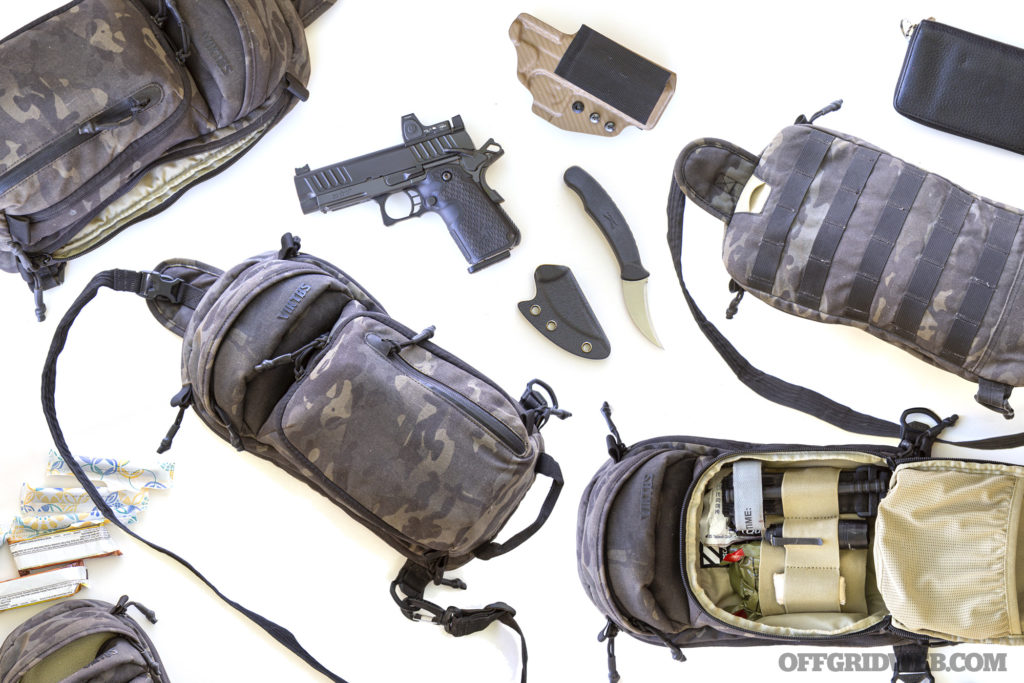
Bag Drop: Viktos Upscale 2 Urban EDC Sling BagThis Viktos Upscale 2 sling bag belongs to one of our female freelance photographers, who wears it instead of carrying a traditional purse.
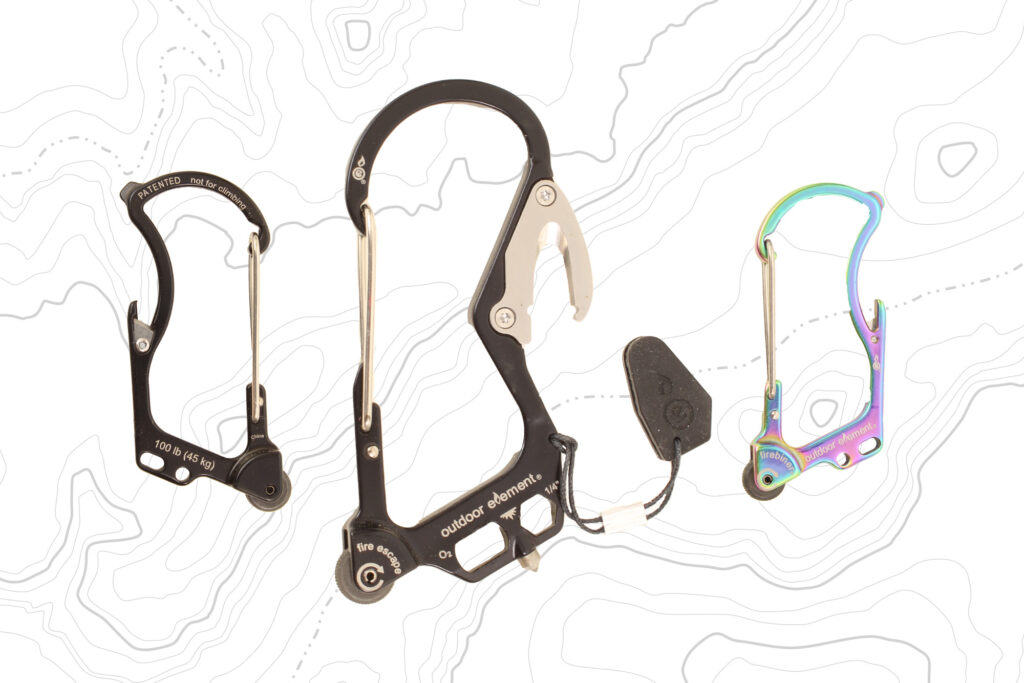
Multitool Firebiner: Outdoor Element's Revamp of a Common Piece of GearWho is Outdoor Element?
Mix a mechanical engineer who used to design equipment for the military, with unquenchable passion for exploring wilderness, and you get: Outdoor Element, a […]
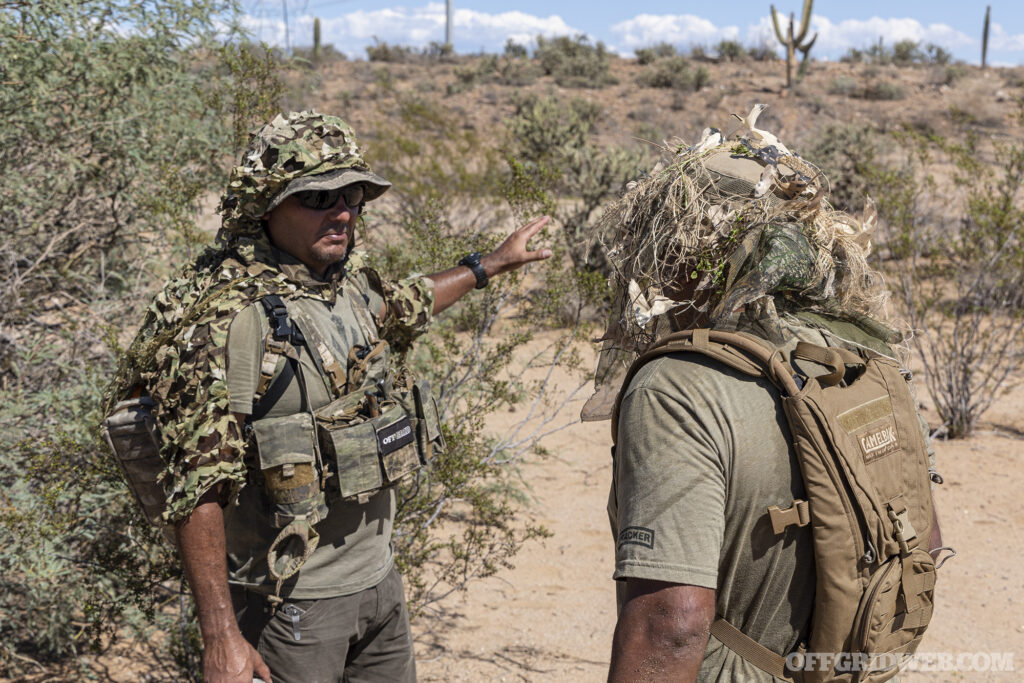
Desert Camouflage Tips from Greenside Training's Arizona Camo ClassI attended a Greenside Training class to learn about desert camouflage patterns, ghillie veils, movement techniques, and observation tips.

Gear Up: New Survival Gear for March 2023We take a look at some of the latest survival gear from Cold Steel, Thyrm, Garmin, Step22, Lester River Bushcraft, Hults Bruk, and more.
The post SLNT E3 Faraday Backpack: A Deep Dive Into Protecting Your Data appeared first on RECOIL OFFGRID.
By: Patrick Diedrich
Title: SLNT E3 Faraday Backpack: A Deep Dive Into Protecting Your Data
Sourced From: www.offgridweb.com/gear/slnt-e3-faraday-backpack/
Published Date: Thu, 01 Jun 2023 11:00:39 +0000
------------------------
Did you miss our previous article...
https://bushcrafttips.com/bushcraft-news/so-is-it-illegal-to-collect-rainwater-in-montana
 What is BushcraftSurvival SkillsToolsVideosBushcraft CampsBushcraft KitsBushcraft ProjectsPrivacy PolicyTerms And Conditions
What is BushcraftSurvival SkillsToolsVideosBushcraft CampsBushcraft KitsBushcraft ProjectsPrivacy PolicyTerms And Conditions
